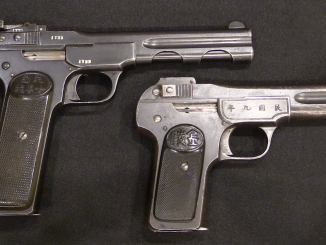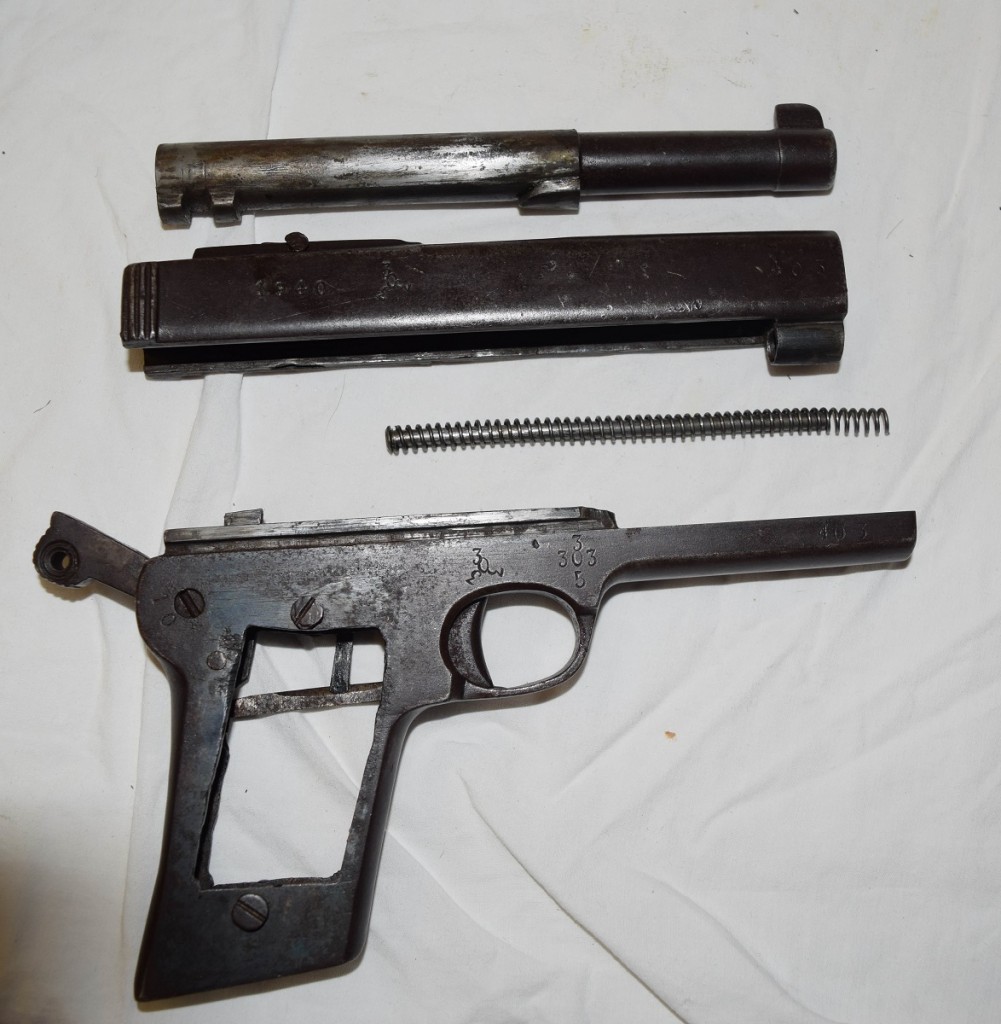I recently did some horse trading with Chuck at GunLab, and he ended up with a couple of my Chinese Mystery Pistols. Today, he pulls one apart to look at the insides…and it’s not a pretty sight. Have a look:
Related Articles

Commentary
What I Didn’t Buy Last Weekend
So this past weekend was a Regional auction at the Rock Island Auction house, which I neglected to post about beforehand. The Regional auctions are the ones with typically lots of less valuable guns packaged […]

Movie review
Movie Review: The City of Life and Death
The Second Sino-Japanese War is a relatively unknown part of the Second World War here in the US. Japanese troops invaded Manchuria in 1931, and by 1937 sporadic skirmishes had evolved into a full-scale war […]

Semiauto pistol
Chinese Warlord Pistols: Shanghai Model 1900 Pistol-Carbine
Get in on the “Pistols of the Warlords” Kickstarter today! Not all of the handguns made in China during the Warlord Era were made one at a time by individual artisan gunsmiths. A few models […]


Be careful– “You’ll shoot (blow) your hand off.”
The frame looks like it was cold forged with a very large hammer. Is that return spring a guide really sufficient? The great videos you have put up on these and other hand-built affairs have really opened my eyes to this craft industry. A whole load of things I have come across in the Balkans, which I wrote off as modern mash-ups for tourists, I now see really were the products of small scale production artisans in the later 19th and early 20th centuries. There’s a fascinating book in this pistols somewhere, a sort of worldwide study.
This looks a lot like my example,although mine has no safety.It does have horn grips and a sculpted fake tangent sight with lots of stamped numbers. I got it for $5 decades ago at a local gunshow.
If I was sure that the breech was SOLIDLY locked when loaded, I’d fire it with MY ammo!
Interesting disconnector, just like on a Star, same side of the pistol as well.
I love these weird Chinese mystery-pistols. As a writer, I find it far more interesting to have my characters encountering crude, unreliable, idiosyncratic weapons than modern guns.
From the photographs I did not see any inscription– Chinese characters.
Were there any?
This says to me one thing: it was never laid on paper prior metal got chewed up. Yuckity-yuck.
They learned how to do it eventually, but still with some oddities and quirks: https://www.youtube.com/watch?v=0ZbRw6Y9s0I
Look at that incredibly forward trigger at rest. Also, machining finish is reported to be poor quality not to mention trigger spring which fades after couple hundred shots and becomes useless.
Very interesting sample for early Chinese auto pistol. Some Webley Scotish, some Rubyish. Firing pin seems “Floating” Type, that is, it can not reach to contact with primer when the hammer manually decocked. This is a clue that the pistol was made some
hard learned experiments that had been made for actual usage with the bottle necked Mauser 7.62 round in Blowback operation. Slide seems in a weight some 400 grams and supposing: 400 meters per second initial velocty, 5 grams of bullet weight, 8/10 square bullet back/case back ratio and 2 miliseconds bullet in the barrel remaining time, results in a value of some 4 milimeters of free blowback travel of unlocked slide during bullet go off. Looks very near in existing standarts of 2-3 milimeters and seems usable in an emergency. Using more powerfull bumpers for violent impact of slide would be better. Comfort is not all the thing(Confucius?…).
“round in Blowback operation (…) seems usable in an emergency”
14 Балтиец pistols were produced during Leningrad Blockade, it was scaled up Walther PP for 7.62×25 Tokarev cartridge. It works properly in −30°С temperature but didn’t enter mass production.
https://ru.wikipedia.org/wiki/Балтиец_(пистолет)
Thanks Daweo. It seems a near replica of 9mm Walther PP/MP. Lighter bullet weight and bigger initial velocity are more convenient sides of rounds in Blowback usability. In fact, especially all hammer firing service pistols can use standart pistol service rounds in Blowback Operation. Rather short stroke of hammer spring and its behaviour in very short time during initial firing through inertia in its upright housing enable some additional resistance against recoiling slide. However, there is an existing example like VP70 showing also the striker firers share the same. What important in using heavy service rounds with unlocked pistol slides should be the softening the violent impact of recoiling breechbolt as beating both the gun and the user. The recoil or return springs should be made for this purpose and their effect in providing additional resistance for breech opening, through inertia, should be limited only with their masses. However, the buffering effect of recoil springs seem not enough to soften the recoil impact and there it needs some additional bumper springs or materials as presented in HK VP70. IMHO.
Am I the only one who kind of wants to try to build something like this with no modern tools just for the experience?
If you do, make a photo or video record – I would love to be able to post something like that! 🙂
I do but it’s illegal here, have fun, if you do as well as this you’ve done pretty well 🙂
I sincerely apologize for detouring off target but, Ian, I think the below is important and your forum is the best source to find answers, to assist the BofATF&E, as well as helping INTERPOL! Are our Chinese friends behind this conundrum of an unregistered MP-?
http://www.thefirearmblog.com/blog/2015/08/11/mystery-9mm-machine-pistol-seized-europe/
Thank you all and please comment.
Pat
And people say that the P38 1911 and baby Browning never had a kids although mrs. Browning has to explain why it came out Chinese